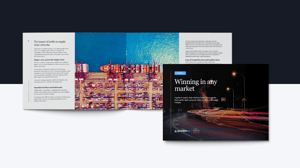Why most AI initiatives stall—and how leading supply chain executives are unlocking real ROI
Artificial Intelligence has exited the realm of theory. For food and beverage manufacturers, AI promises to modernize aging infrastructure, respond dynamically to volatile demand, and cut waste in an era where margins are under siege. But while the potential is vast, so is the gap between promise and performance.
According to Santiago Lopez de Haro, Director of Advanced Analytics at Spinnaker SCA, “AI isn’t failing because the technology doesn’t work—it’s failing because organizations haven’t laid the right operational and architectural foundations.” And he’s right. While the market for AI in food and beverage is forecasted to quintuple from $7B to $35B by 2028, most supply chain leaders are still struggling with the basics: Data quality, system integration, skill gaps, and creeping implementation costs.
This blog distills key executive takeaways from the comprehensive PreScouter report: “Will AI Revolutionize F&B Supply Chains by 2028?”
Data is your weakest link—not the algorithm
“Garbage in, garbage out. It doesn’t matter how good your algorithm is if your data is wrong.” — Santiago Lopez de Haro
The most consistent failure pattern across AI pilots? Poor data hygiene. Many companies pour millions into capture technologies—IoT sensors, POS integrations, even blockchain—but fail to budget for cleansing and standardization. Most data scientists still spend 80% of their time triaging bad data rather than building predictive models.
Executive move: Prioritize data governance frameworks that start with operational usage. Clean, curated, decision-ready data is a prerequisite—not a byproduct—of AI ROI.
Infrastructure cost overruns are avoidable
Cloud AI isn’t free. And SaaS models with low entry barriers can explode in cost once user adoption scales.
“CIOs must monitor infrastructure expenses monthly, not quarterly. Waiting to validate costs until you get the invoice is far too late.” — Lopez de Haro
Executive move: Demand time-phased infrastructure cost scenarios. Forecast TCO under multiple adoption curves and consider engaging firms with hybrid CapEx/OpEx models or ROI-linked pricing to mitigate burn risk.
System disparity is the silent killer of AI
“You can’t build an autonomous supply chain if your ERP, TMS, and WMS can’t talk.” — Lopez de Haro
AI doesn’t replace legacy systems—it depends on them. Most AI failures stem from brittle integrations or incomplete visibility across suppliers, plants, and logistics networks. A federated data lake is a strong start—but not the end state.
Executive move: Fund interoperability. Prioritize middleware and master data architecture before piloting AI for forecasting, inventory optimization, or transportation planning.
Change management is the hidden cost center
Even perfect AI models will fail in the hands of untrained or resistant users. Lopez de Haro warns that too many executives underestimate the human transformation AI requires.
“You need change catalysts—people who understand both business and data. These are rare, but they exist.” — Lopez de Haro
Executive move: Build a hybrid team of operators and analysts. Upskill internal SMEs while augmenting with specialized AI-savvy supply chain consultants. Think Black Belts for digital.
Not all AI partners are created equal
Beware of “AI-washed” vendors. Many off-the-shelf solutions run on static models that degrade over time.
“Most vendors don’t support continuous learning. Their models are trained once—and never touched again.” — Lopez de Haro
Executive move: Vet partners on three criteria: 1) Do they model feedback loops and data drift? 2) Can they integrate across your unique supply chain tech stack? and 3) Have they delivered real results in environments like yours?
AI can deliver 10x ROI—but only with the right playbook
Lopez de Haro puts it bluntly: The cost of waiting often exceeds the cost of getting started. But jumping into AI without a plan is a recipe for disappointment.
Want the full story? This expertly-researched guide features insights from industry leaders at Spinnaker SCA, JBS, and global F&B giants—and walks you through both the hype and the execution realities. Download the full PreScouter report ↗



